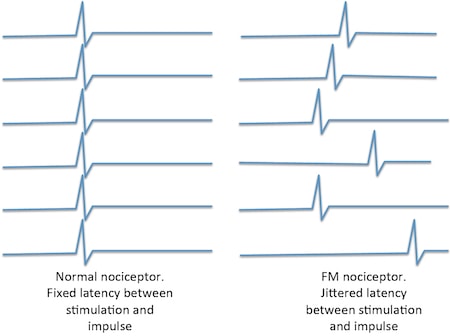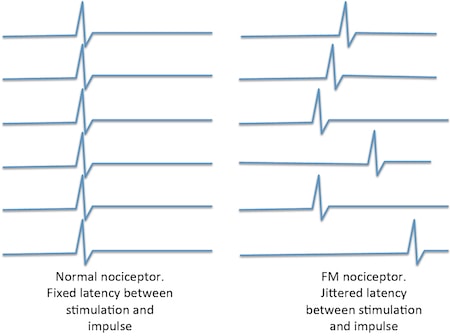Lorimer went to a splendid topical workshop at the World Congress on Pain. The workshop was about the relative contribution of periphal and central contributions to fibromyalgia. There were three speakers. This blog will focus on the first – Jordi Serra from Barcelona.
Jordi is a neurologist and is doing some excellent work with microneurography. Microneurography is as it sounds – teeny weeny electrodes inserted in nociceptors of humans. He has shown that in healthy humans, there is no spontaneous discharge of nociceptors. I was surprised by this because I was of the view that they did show spontaneous activity. How does he know? Great question. They use a groovy trick whereby the nociceptors are stimulated at .25 Hz and the action potentials thus generated are recorded downstream on the neurone. If there is no sponaneous activity in the neurone, then the latency from stimulation to an action potential being recorded somewhere else along the neurone, remains constant. It would look like the left panel in the picture:
however, if there is any spontaneous activity, it will result in silent periods of the neurone, then the latency will vary a bit, like the right panel in the picture.
Jordi showed that, in people with fibromyalgia, the latency is jittered in about 30% of fibres. Not people, but fibres. This, he argued, is evidence of a peripheral nociceptive driver in FM. However, one of the questions afterward was on the money – Kathleen Sluka noted that there are very plausible mechanisms by which the CNS could be causing that spontaneous discharge via peptidergic activation. That is, nociceptors are activated in the dorsal horn and then release subtance p and CGRP and, bingo, spontaneous activity.
Jordi also discussed two other interesting findings in FM patients. First, a weird type of peripheral sensitisation, in which a single sitmulation will cause after discharge and many seconds of neuronal activity. Second, drastic reduction in nerve conduction velocity – we are talking drastic too – a reduction in conduction velocity that was larger in size than that observed in frank neural pathology eg diabetic neuropathy. It was elegant and powerful stuff. However, it came short of convincing me that this is evidence of peripheral drivers. So much remains unclear – why would the neurones go bananas just where they do? What is the chicken and what is the egg? These questions should keep Jordi and his excellent team of merry neurophysiology men busy for some time.
About Lorimer Moseley
 Lorimer is NHMRC Senior Research Fellow with twenty years clinical experience working with people in pain. After spending some time as a Nuffield Medical Research Fellow at Oxford University he returned to Australia in 2009 to take up an NHMRC Senior Research Fellowship at Neuroscience Research Australia (NeuRA). In 2011, he was appointed Professor of Clinical Neurosciences & the Inaugural Chair in Physiotherapy at the University of South Australia, Adelaide. He runs the Body in Mind research groups. He is the only Clinical Scientist to have knocked over a water tank tower in Outback Australia.
Lorimer is NHMRC Senior Research Fellow with twenty years clinical experience working with people in pain. After spending some time as a Nuffield Medical Research Fellow at Oxford University he returned to Australia in 2009 to take up an NHMRC Senior Research Fellowship at Neuroscience Research Australia (NeuRA). In 2011, he was appointed Professor of Clinical Neurosciences & the Inaugural Chair in Physiotherapy at the University of South Australia, Adelaide. He runs the Body in Mind research groups. He is the only Clinical Scientist to have knocked over a water tank tower in Outback Australia.
Link to Lorimer’s published research here. Downloadable PDFs here.




